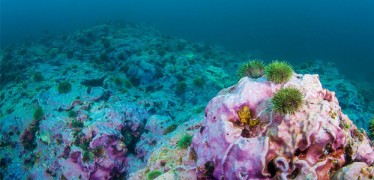 University of Maine marine scientist Bob Steneck is part of an international team that has unlocked an underwater time capsule in the North Pacific that has been monitoring the climate for centuries.The time capsule is the long-living, slow-growing alga Clathromorphum nereostratum that creates massive reefs in shallow coastal regions of Alaska’s Aleutian archipelago. These solid calcium carbonate structures have fine growth rings — similar to tree growth rings — which Steneck says contain historical environmental information.
University of Maine marine scientist Bob Steneck is part of an international team that has unlocked an underwater time capsule in the North Pacific that has been monitoring the climate for centuries.The time capsule is the long-living, slow-growing alga Clathromorphum nereostratum that creates massive reefs in shallow coastal regions of Alaska’s Aleutian archipelago. These solid calcium carbonate structures have fine growth rings — similar to tree growth rings — which Steneck says contain historical environmental information.
The team used a cutting-edge microisotopic imaging technique to reconstruct 120 years of seasonal changes in ocean acidification (pH) in the region. The technique uses lasers to measure isotope ratios of the element boron at the scale of tenths of millimeters.
The technique, Steneck says, provides researchers with a detailed historical timeline, including rate of ocean acidification both seasonally and over hundreds of years. The scientists learned that since the late 19th century, the ocean has been acidifying at a rate that corresponds with rising carbon dioxide levels in the atmosphere.
“The next frontier is to determine millennial records so we get a better sense of what was normal for ocean acidification in cold water coastal zones,” Steneck says.
The alga grows approximately 1 millimeter every three years, so plants collected last year that are nearly half-meter thick could easily be more than 1,000 years old, he says.
“These and similar types of coralline algae are living in all oceans,” says lead researcher Jan Fietzke of the GEOMAR Helmholtz Centre for Ocean Research Kiel in Germany. “Thanks to laser ablation techniques, in the future we can use other samples to look much further back into the past…”
In fact, UMaine postdoctoral associate Doug Rasher is currently in Scotland analyzing specimens that he and Steneck collected last year in Alaska.
The team’s seasonal analyses also indicated strong variations of pH in each year.
The researchers, who also hail from the United Kingdom and Canada, say the annual variation is likely due to large kelp forests in the region that consume large amounts of carbon dioxide in the spring and summer as they grow. The kelp forests then completely die back each winter.
“In a sense, these ecosystems are breathing by inhaling CO2 each summer and releasing it every winter,” says Steneck, who is based at the University of Maine Darling Marine Center in Walpole.
Each year, more carbon dioxide enters the atmosphere, some of which is absorbed by the ocean as carbonic acid. This, in turn, decreases the pH and increases acidity of the ocean, say the researchers.
Steneck says 90 percent of marine resource value in Maine involves shellfish, including lobsters, scallops, oysters and clams. Lobsters and other organisms depend on high pH to create limestone shells and it takes metabolic energy to make limestone.
When the ocean is more acidic, the metabolic cost necessary to make shells increases, he says. Some energy that would normally be allocated to organisms’ immune systems could be compromised, possibly increasing their susceptibility to disease.
Lobsters afflicted with shell disease increased fivefold between 2010 and 2012 in Maine; in southern New England during that time, scientists and lobstermen indicated that one in four lobsters caught was diseased.
Steneck says being able to determine if acidification in a specific coastal area might be affected by extreme rainfall events or sewage treatment, for example, could help create more localized ocean management policy.
To retrieve specimens for the research, Steneck dove in 34-degree water off the Aleutian Islands and used a jackhammer to cut off chunks of the Clathromorphum nereostratum. The chunks were loaded into cargo nets, airlifted to the surface, towed to the boat and lifted aboard with a crane. Onboard, Steneck cut the chunks into pieces for research.
A paper about the findings will be published Feb. 24 in the Proceedings of the National Academy of Sciences journal.
Contact: Beth Staples, 207.581.377
